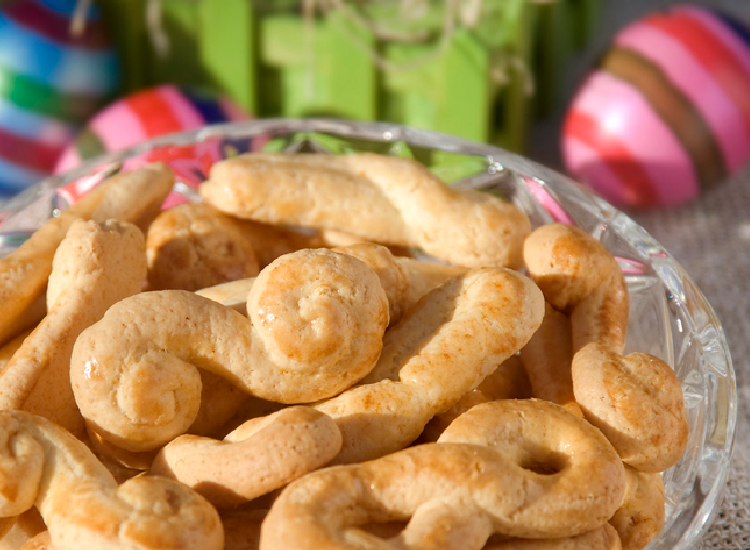Bakery - Pastry
EASTER COOKIES

There are many traditional Easter sweets from region to region, but three are the most popular and common in Greece: tsoureki buns, chocolate eggs and Easter cookies.
In this article we will take a look at Easter cookies and the role of their individual ingredients from a technical point of view, in the success of the finished product.
As in any cookie, the main ingredients are fat, sugar and flour, along with eggs, flavorings, liquids (milk or juice) and baking agents.
Let’s analyze them further:
Flour
The role of flour in the preparation of Easter cookies is the proper binding of the individual ingredients: fat, sugar, liquids.
The most suitable flour for cookies is biscuit flour.
It is important that this flour has a proper particle size, that is, it is very finely ground so that it can absorb and “bind” the ingredients of the recipe using as little flour as possible, so that the sugar and fat has more effect in the final flavor.
For this reason, it is produced by mills with special milling and processing technologies to have the right characteristics:
Milling rate: 65-70%
Protein: 8-9%
Ash: 0.45-0.55%
Occasionally, some reducing agents or proteolytic enzymes may aid in the rheological characteristics of the dough.
This type of flour therefore produces a soft, pliable dough with low elasticity, which does not strain and with good extensibility.
Sugar
Sugar beyond sweetness has a significant effect on self-life (by reducing water activity, aw), color, texture and cookies spreading.
A small amount of sugar will give us unsweet, soft and colourless cookies, while an excessive amount will create a very hard cookie, with a strong dark colour and overly sweet.
Sugar granulation is important both for its solubility in the dough during mixing and for its degree of baking: large sugar crystals lead to intense cookie spreading and vice versa. So a good solution is to use powdered sugar, but taking into account the percentage of starch usually contained in the powder (about 3%) as an anti-caking agent.
Fat
After flour and sugar, fats are the largest and most important ingredient in most cookies recipes.
In the past, most common used fats were animal derived (milk butter), while in recent decades the use of vegetable fats has increased.
Although the butter tastes superior, the reason why the vegetable fats gained ground, in addition to reducing costs, is their ability to retain their fresh taste and aroma and to be more stable in rancidity due to their natural antioxidants they contain.
When mixing the dough, the aqueous phase and the fats compete for what will come to the surface of the flour particles. When the fats overlay the flour before hydrating, the formation of the gluten mesh is inhibited, resulting in the production of softer dough.
The crystalline structure and size of the lipidis have a significant effect on the retention of air in the dough mass, with the smaller crystals permitting greater gas retention.
Another role of fats is to reduce the friction created by sugar and flour while mixing, as well as to prevent the cookies from sticking to the tray during baking.
Finally, fats contribute significantly to the organoleptic characteristics: the taste and aroma of cookies.
Eggs
The egg comprises about 40% of the yolk and 60% of the egg white (albumin). Except of its nice yellowish color with the carotenoids it contains, yolk is a very good source of many nutrients, such as vitamins A, D, E, folic acid, biotin and choline. However, its main technological role in the buns is its emulsifying property (emulsifiers help to avoid fat separation) due to the lecithin it contains.
Egg white helps in the consistency of the dough, with a better “bind” of the ingredients, and should be calculated in the recipe fluids, as it contains about 80% water.
Milk
Milk contributes to the Easter cookies recipe by giving them a slightly sweet taste and colour, and also in better consistency and pliability of the dough. It is important to be lukewarm during mixing, so that the fat does not freeze and the dough becomes curd. The same applies to eggs.
Salt
Although in small percentage, the role of salt is to balance the intense sweet taste of sugar, but also to emphasize the flavours and aromas of the other ingredients as the slightly salty taste irritates the taste buds of the tongue resulting in a stronger sense of all other flavours.
It also contributes to better cookie self-life by reducing water activity (aw).
Baking agents
Baking agents increase the volume, giving porous structure to the cookie and making it crispy.
Although there are some Easter cookie recipes using yeast as a baking agent, it is much more common to use chemical baking agents such as baking soda, baking powder and ammonia.
Flavourings
Although Easter cookies, like all cookies, develop characteristic flavors and aromas of baked goods due to the individual ingredients (sugar, egg, fat, flour), however, flavourings like vanilla or zest are added to balance the intense flavour of eggs and butter.
Papapanagis Diamantis
Food Technologist – R&D
MILLS OF CRETE